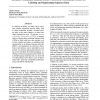236 search results - page 9 / 48 » Learning How to Propagate Using Random Probing |
AAAI
2010
13 years 5 months ago
2010
Search based solvers for Quantified Boolean Formulas (QBF) have adapted the SAT solver techniques of unit propagation and clause learning to prune falsifying assignments. The tech...
IJCNN
2006
IEEE
14 years 1 months ago
2006
IEEE
— We propose a method that takes observations of a random vector as input, and learns to segment each observation into two disjoint parts. We show how to use the internal coheren...
FLAIRS
2007
13 years 10 months ago
2007
Problem solvers, both human and machine, have at their disposal many heuristics that may support effective search. The efficacy of these heuristics, however, varies with the probl...
NIPS
2008
13 years 9 months ago
2008
This paper studies global ranking problem by learning to rank methods. Conventional learning to rank methods are usually designed for `local ranking', in the sense that the r...
ICML
2004
IEEE
14 years 8 months ago
2004
IEEE
In sequence modeling, we often wish to represent complex interaction between labels, such as when performing multiple, cascaded labeling tasks on the same sequence, or when longra...

